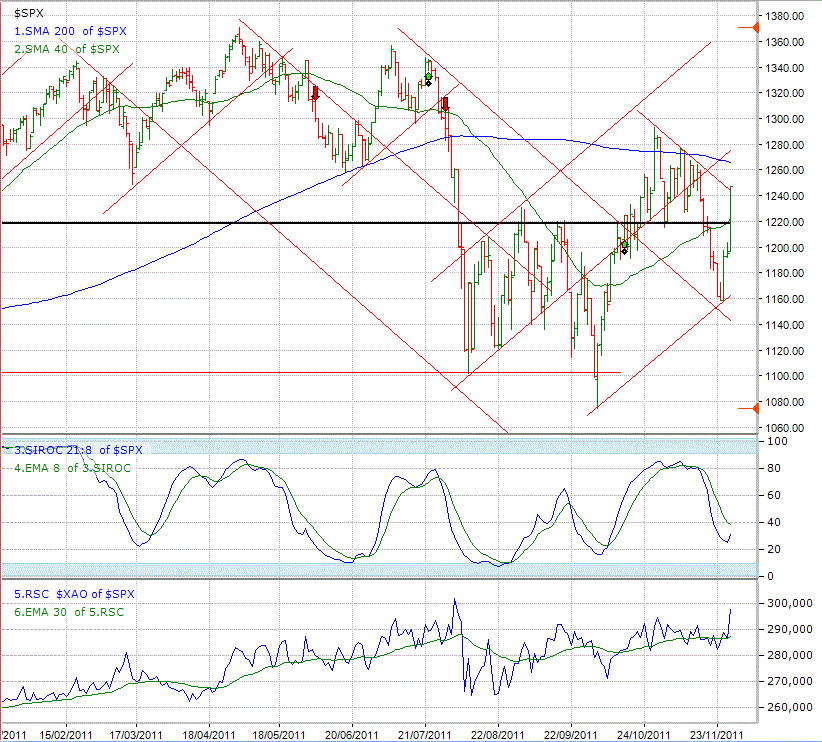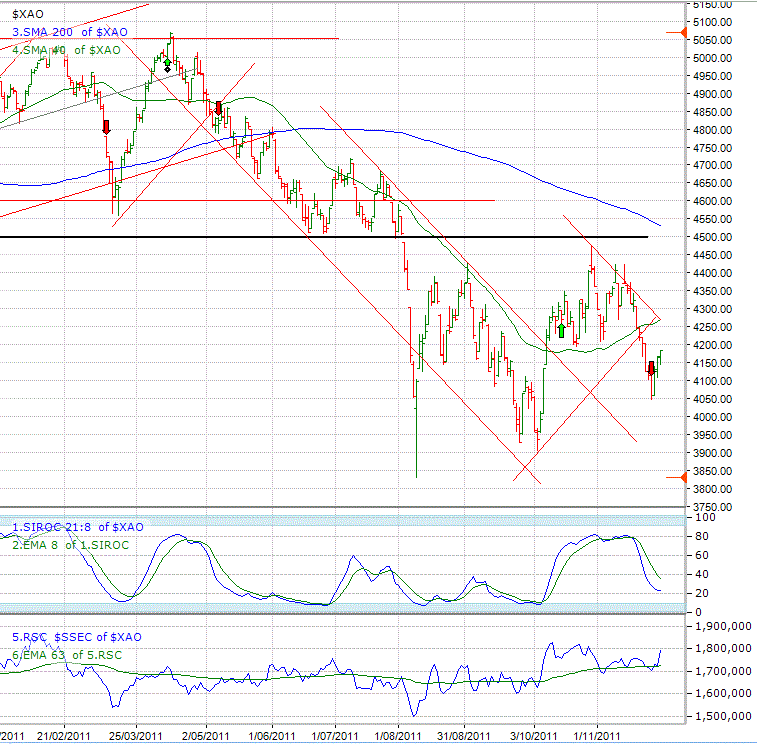Gary’s Comments
Last night most of the international equity indices changed from short term down trends to short term up trends, in the table below. The three USA indices were already in Long Term Up Trends, according to our Intelledgence system’s rules. Note though that the Risk Status is still High for these indices.
The back drop to world equity markets is still poor. The problems being dealt with are significant in nature as governments’ appetites for debt the world over clash directly with the economic fall out of them living way beyond their means over the last two decades. Despite this back drop equity indices are trying to rise.
As I have said many times before in the this newsletter, economies and markets are seldom in sync. If they were, the Australian bourse would have risen strongly during the GFC period when our economy was relatively so strong compared to all other economies around the world. Markets look forward and economic data looks back.
There are many stocks in Australia trading at low PE’s and hence high earnings yields (EY). For example, the four major banks have PE ratios ranging from 8.8 to 11.9, EYs from 8.3% to 11.3% and 100 franked DYs from 6.7% to 7.5%. The two biggest resource companies in Australia, BHP and RIO, have a PE Ratio of 8.7 & 8.6 and EY of 11.4% & 11.6%, respectively. The overall ASX has a PE of 11.88 and the long term average is around 16. Dell, listed on the Nasdaq, has a PE Ratio & EY of 8.4 & 12.3%, respectively. Compared to historical average PE Ratios and EYs, these would indicate very good value. And many other stocks are have similar ratios.
However, sentiment is obviously still negative due to the economic concerns in the major trading blocs around the world. Throw some positive sentiment into the mix and things could change quite rapidly.
Note that the JSE All Share Index is 1.3% away from a new all time high while the ASX is 39% below it’s all time high and the S&P500 is 20.4% below.
Lastly, some of the contrarian indicators are near extremes. For example, trading volumes are at extreme lows amongst retail investors as they have fled the market in droves over the last 12 – 18 months and sentiment indicators such as net new cash flows into mutual funds are also approaching extremes with 7 straight months of outflows. It’s usually at these times that things can change.
| Overseas Markets Report | |||||
| Index | Close | % Change | IntelledgenceRisk Status | Short Term Trend | Long Term Trend |
| Dow Jones | 12045.68 | 4.80% | Neutral – HIGH | Up | Up |
| SP 500 | 1246.96 | 4.96% | HIGH | Up | Up |
| Nasdaq | 2620.34 | 3.93% | HIGH | Up | Up |
| FT 100 | 5505.42 | 7.11% | HIGH | Up | Down |
| Dax | 6088.84 | 11.56% | HIGH | Up | Down |
| CAC 40 | 3154.62 | 11.77% | HIGH | Up | Down |
| Nikkei | 8434.61 | 1.44% | HIGH | Up | Down |
| Hang Seng | 17989.35 | 0.70% | HIGH | Down | Down |
| SSE-All | 2333.41 | -2.57% | HIGH | Down | Down |
Some commodities also changed from short term down trends to short term up trends last night, in particular Copper and Gold.
Some commentary on the $US. A cycle has established itself over the last couple of years whereby the $US moves counter to equity and most commodity markets. This means that when equities and commodities rise the $US falls, and vice versa. This also means that many commodities are moving is a similar direction (not necessarily magnitude) as equities, at least on a daily basis. This means that the $A and ZAR tend to rise when equity markets rise.
This relationship has not always been in place and should change again at some stage but for the time being to this means that the $A and ZAR will get stronger against the $US if equity markets rally, and get weaker if equity markets fall as the $US remains the safe haven against equity weakness.
| Commodities | |||||
| Index | Close | % Change | Intelledgence Risk Status | Short Term Trend | Long Term Trend |
| Brent Oil | 110.82 | 1.64% | LOW | Up | Up |
| Gold | 1745.5 | 2.53% | LOW – Neutral | Up | Up |
| Copper | 356.3 | 6.90% | HIGH | Up | Down |
| Lead | 1999 | 1.16% | HIGH | Up | Down |
| FX-$-EUR | 1.3441 | 0.80% | HIGH | Down | Down |
| US $ Index | 79.007 | 0.95% | LOW | Up | Up |
| CRB Index | 313.82 | 0.93% | HIGH | Down | Down |
| Silver | 3273.1 | -0.67% | HIGH | Down | Down |
| Zinc | 1936 | 0.36% | HIGH | Up | Down |
| FX-$-AUD | 1.0274 | 6.09% | HIGH | Up | Down |
| Platinum | 1560.8 | -0.65% | HIGH | Down | Down |
The S&P500 moved back into its dominant trading zone of the past few years, that is, above 1220. It next major resistance zone is 1300 – 1320 and support is the level it just broke above, 1220. This is a significant move.
The next few days will tell whether last night’s move was mainly short covering or strong buying. Technically, the S&P500 has registered a higher low and now needs to make a higher high, preferably above 1300. This is the next key technical criterion that needs to be met.
The daily SIROC has turned. The SMA 40 is rising and price is approaching the SMA 200 again. The S&P500 has reached its downtrending trend line above. It will either break above this resistance line with gusto or retrace to or near the rising trend line below. The former would be far more bullish.
| Local Market Report | |||||
| Index | Close | % Change | Intelledgence Risk Status | Short Term Trend | Long Term Trend |
| All-Ords | 4184.7 | 1.43% | HIGH | Down | Down |
| Information Technology | 500.3 | 0.14% | HIGH | Down | Up |
| Consumer Discretionary | 1220.3 | 0.84% | HIGH | Down | Up |
| Materials | 10930.05 | 1.21% | HIGH | Down | Down |
| Energy | 13415.6 | -0.10% | HIGH | Down | Up |
| Property Trusts | 811.7 | 5.80% | LOW | Up | Up |
| Financials | 3914.7 | 3.34% | HIGH | Down | Up |
| Consumer Staples | 7444.2 | -0.81% | HIGH | Down | Up |
| Health Care | 7842.3 | 0.98% | HIGH | Down | Up |
| Telecommunications | 1081.2 | 1.21% | LOW | Up | Up |
| Industrials | 3387.5 | 1.51% | Neutral – HIGH | Down | Up |
| Utilities | 4439.6 | 0.26% | LOW – Neutral | Down | Up |
The ALL ORDS continues to lag the S&P500 and the JSE-ALSH. Compare this chart to the S&P500 above to note the obvious relative weakness. While the $A cycle with the $US, as mentioned above, remains in place, i.e. the $A will strengthen when US equity markets rise(and hence the All Ords rises), it is difficult to see how the All Ords can catch up as the strong $A seems to be a handbrake on Australian equities. This is not the case with the JSE whihc is near all time highs.
This leaves one to ponder what may break this cycle and get a rising All Ords again, which will need the 4 main banks and large resources companies to start rallying strongly. Possibly a fall in our interest rates and / or a corresponding rise in US interest rates or genuine investment interest in Australian stocks pouring in from offshore, something that appears to have been lacking over the last two years.
Whatever it is, when it does break get ready to act as it may be a fantastic rally against a high risk back drop. However, the dampener of Europe still hangs above our heads like the sword of Damocles………….
The SPA3 public portfolios continue to outperform the market by a large margin. See the performance table below that shows the comparative compounded annual returns.
| Portfolio Summary | |||||||
| Portfolio | 16/11/2011 | 23/11/2011 | 30/11/2011 | Weekly Move % | Top Mover | % Gain | |
| Intelledgence | $409,806.36 | $396,750.43 | $401,916.57 | 1.30% | MAH | 3.39% | |
| SPA3 Portfolio | $417,651.05 | $404,825.87 | $403,779.21 | -0.26% | IIN | 9.23% | |
| SPA3 Hedge | $488,672.81 | $478,853.02 | $470,500.77 | -1.74% | BRU | 5.98% | |
| SPA3CFD | $49,451.53 | $45,510.20 | $42,956.48 | -5.61% | WEB | 0.00% | |
| Compounded Annual Return | ||||
| Portfolio | 1 Year | 3 Year | 5 Year | 10 Year |
| SPA3 Portfolio | -15.17% | 6.65% | 3.86% | 13.03% |
| SPA3 Hedge | -10.47% | -2.33% | 6.71% | 14.24% |
| SPA3 CFD | -34.86% | 12.27% | N/A | N/A |
| All-Ords | -10.52% | 4.45% | -5.19% | 2.48% |
| All-Ords Accum Index | -6.59% | 9.04% | -1.12% | 6.77% |
Share Wealth Systems provides more detail on all of the above items at our eUGMS. The eUGMs are monthly multimedia presentations available to Share Wealth Systems members only.
The figures used in this Active Investor are based on data prices as of: 30/11/2011


